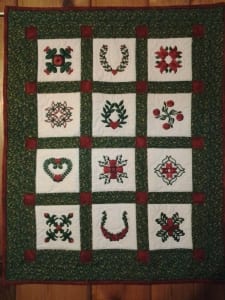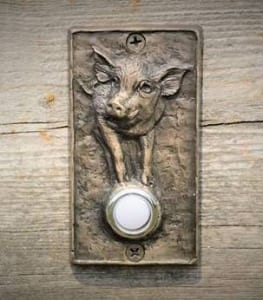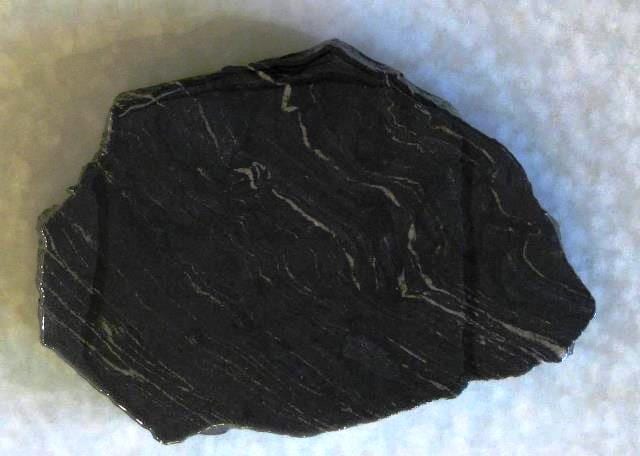Pottery Mom — Functional Clay by Merrilyn Reeves

The leaves and fruit of the Northwest’s wild blueberry are a signature embellishment on Merrilyn Reeve’s Huckleberry Bowl.
Not many women in modern USA boldly call raising a family a career, but potter Merrilyn Reeves isn’t afraid to do so. Years before she embarked upon a second career that is now 33-years in progress and counting, she raised four children on 17 acres in a remote area of rural Idaho. Their nearest neighbors were six miles away. The radio worked in the car, not the house. The deer that interacted with the family’s laying hens, goats, and cattle had to contend with a “rifle packing momma who had to feed her kiddos.”
The last thing on her mind, at that time, was throwing pots.
“Keeping dirty things clean (faces, bottoms, clothes, floors, dishes), food on the table, and clothes on little bodies occupied most of my time and energy,” the Plummer, ID, artist says. It wasn’t until she was on a vacation with her still-young family to Yellowstone and chanced to observe a professional potter plying his craft, that pottery first entered into her heart and hopes.

Through the years, Merrilyn Reeves has developed her own special formulas for the glazes she used on her pottery. Blue Rice Bowls with Chopsticks.
“I was mesmerized as I watched him skillfully turn that lump of clay into a recognizable vessel. He was amazing and I was very taken with the process and result.”
She Gave the Pottery Wheel a Whirl
A few years later, she took a class where she sat down at the wheel for the first time, and, literally, gave it a whirl.
“I wore a suit — a poor choice for a pottery class! Prior to that day, the thought that I might be an artist had never entered my mind. I could not imagine doing anything passable with a paint brush.”
Since that memorable day in 1988, Reeves has created hundreds of pots using a wheel very similar to the one on which she threw her first pot. She also experiments with hand building and alternate throwing forms, using porcelain, stoneware, and earthenware clays in a variety of applications. The learning curve, like the wheel itself, is constantly turning, and each project is an opportunity to learn more about the medium: Moisture content in clay varies widely, and if it’s too firm or too soft, it won’t throw right. Glazes, too, are finicky, and must “fit” the particular clay, with both expanding at about the same rate to result in a good, durable glaze without major defects.

Grass, leaves, and flowers are a favorite embellishment of Merrilyn Reeves to either paint onto the pottery or incorporate via organic materials. Oval Grass Bowl by Merrilyn Reeves.
And despite what Reeves thought, she did learn to use a paintbrush, frequently embellishing pieces with images of leaves and flowers.
God’s Creation Provides the Finishing Touches
“God’s creation provides much inspiration for my pots, particularly in the finishing touches,” Reeves says. “When I need an idea, I am apt to take a walk and see what is growing in the area. The grasses and weeds I collect just may end up on the next generation of my pots. Many items from nature are fun to play with, whether leaves, whole plants, stones or sea shells.
“I have to say that bugs don’t make the grade, and have never ended upon on a pot. Yet.”
Reeves specializes in functional ware, defining each piece as possessing a purpose, which, in part, is determined by the person who “adopts” it.
“My goal is to enrich the lives of others with my pots,” she explains. “I give my best to each pot, hoping that it will encourage and brighten someone’s day and life.”
Be Fair and Do What’s Right
This way of approaching pottery, she adds, is an extension of her world view, which is that God created the earth, and He has a plan for each person in it.
“For me His plan included pottery, and He gave me the skill and aptitude for it.
“I guess this is not a popular stance these days, but it should always be in style to do what is right. We should do the best job when making items for others to ‘adopt,’ charging a fair price, and dealing honestly with others. I hope that shows in my work.”
Reeves works from a free-standing studio, separate from the home she shares with her husband Waverley and their two black labs, Rosie and Sasha. The four children resulted in 14 grandchildren and five great grandchildren. The initial pottery class resulted in a business, Wildwood Pottery, where Reeves hand-crafts each piece from start to finish, including the all-important smoothing of the foot so that the finished pot will be kind to any furniture surface it rests upon. It’s these little things, Reeves believes, that aren’t so little after all — whether they are children being raised by a career mom or whether they are one of her signature huckleberry bowls.
“I give careful attention to each step of the process,” Reeves says.
“A person purchasing one of my pots reaps the investment of many hours of my time and care.”
 Merrilyn Reeves is the featured Art Event at Wenaha Gallery from October 5 through November 1, 2021.
Merrilyn Reeves is the featured Art Event at Wenaha Gallery from October 5 through November 1, 2021.
Contact the gallery, located at 219 East Main Street, Dayton, WA, by phone at 509.382.2124 or e-mail art@wenaha.com. Gallery hours are 9 a.m. to 5 p.m. from Monday through Friday, and by appointment. Visit the Wenaha Gallery website online at www.wenaha.com.






























